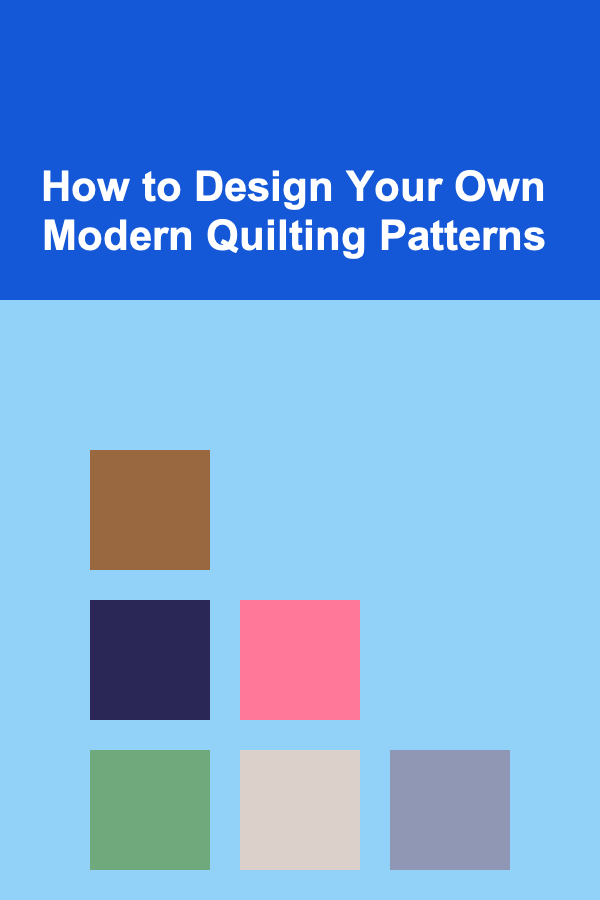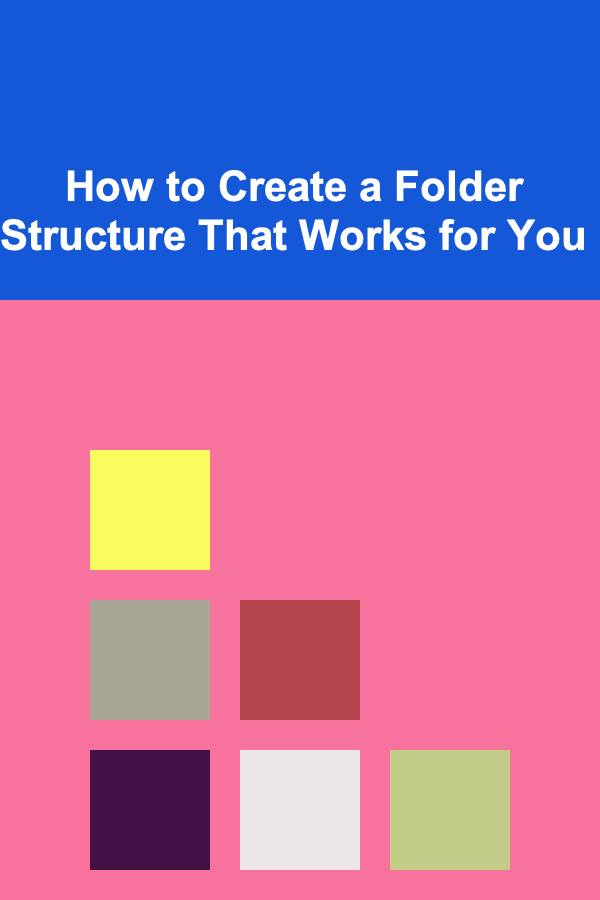
How to Design Your Own Modern Quilting Patterns
ebook include PDF & Audio bundle (Micro Guide)
$12.99$6.99
Limited Time Offer! Order within the next:

Quilting is an ancient craft that has evolved over centuries, blending both traditional techniques with contemporary styles. Today, modern quilting has carved out a niche in the world of fabric arts, incorporating minimalism, bold geometric shapes, and fresh color palettes. If you're looking to design your own modern quilting patterns, you're in the right place. This article will guide you through the process, from understanding modern quilting principles to the technical aspects of creating your own unique designs.
Understanding Modern Quilting
Before diving into pattern creation, it's essential to understand what sets modern quilting apart from its traditional counterpart. Modern quilting embraces a more relaxed, contemporary approach, prioritizing artistic expression over uniformity or rules. Here are some key characteristics of modern quilting:
1. Bold, Graphic Designs
Modern quilters often focus on bold, graphic patterns rather than intricate, detailed ones. Geometric shapes like triangles, rectangles, and circles are common, often arranged in a minimalist way.
2. Minimalism
Less is more in the world of modern quilting. Simple, clean lines and negative space are frequently used to create balance and emphasize the main elements of the design.
3. Color Play
Modern quilting allows quilters to explore new color combinations, often using bright, unexpected hues or muted tones. The color palette is an essential part of the design, and many modern quilters opt for solid fabrics over prints to create a sleek, contemporary look.
4. Asymmetry and Improv Quilting
Rather than following exact measurements or pre-determined patterns, modern quilters often embrace asymmetry and improvisational methods. This creates a sense of freedom and spontaneity in the designs.
5. Negative Space
Negative space---areas of the quilt that are left unsewn---is a defining characteristic of modern quilts. This space gives the design room to breathe and allows the geometric shapes to stand out more clearly.
With these elements in mind, you can begin to design your own modern quilting patterns.
Step-by-Step Guide to Designing Your Own Modern Quilt Patterns
1. Start with Inspiration
The first step in designing any quilt pattern is finding inspiration. Inspiration can come from various sources, including nature, architecture, art, or even other quilts. Some designers look at urban landscapes for the geometry in city grids, while others may find inspiration in the organic forms of plants or animals.
Sources of Inspiration:
- Nature: Plants, flowers, water, and landscapes can provide stunning color palettes and natural shapes for quilting.
- Architecture: The clean lines and geometric forms of buildings and cityscapes are perfect for modern quilting.
- Art: Abstract art, such as the works of Mondrian or the Bauhaus movement, can inspire striking and geometric designs.
- Photography: A simple photograph of a scene, person, or object can often translate into a quilt design.
2. Choose Your Quilting Style
Once you have your inspiration, decide what kind of quilting style you want to pursue. While traditional quilting often revolves around a specific block, modern quilting opens up possibilities for diverse styles. Here are a few common styles to consider:
a. Geometric Designs
Geometric quilts focus on basic shapes---triangles, squares, and diamonds---arranged in a visually striking way. You can experiment with repeating patterns, rotations, or shifting the placement of the shapes.
b. Improv Quilting
Improvisational quilting is a freestyle method of quilting where you sew pieces of fabric together without following a precise pattern. This style often has an organic, unplanned feel, making it ideal for creating bold, dynamic quilts.
c. Minimalist Quilting
If you want to make a statement with less, minimalist quilting may be your preferred style. Think of large blocks of solid fabric with plenty of negative space around them. You can still play with shapes but focus on creating a clean, uncluttered design.
d. Strip Quilting
Modern strip quilts focus on long strips of fabric sewn together in various patterns. This is a simple yet effective way to create bold designs using just one or two types of fabric.
3. Choose Your Fabrics and Color Palette
Fabric choice is crucial in modern quilt design. Modern quilters often use solids or limited patterns to keep the overall aesthetic clean and bold. However, some quilters do incorporate modern prints, so long as they don't overwhelm the design.
Choosing Fabrics:
- Solids: Modern quilters love using solids, which allow the shapes and designs to take center stage. You can use solids in a range of colors to build your palette.
- Modern Prints: If you want to use prints, stick to geometric or abstract prints that complement the overall style of the quilt.
- Textured Fabrics: Adding a textured fabric, like linen or shot cotton, can create visual interest without detracting from the design.
Selecting Your Color Palette:
- Bold Contrasts: Choose a color palette that uses high contrast, such as black and white or bright, saturated colors paired with neutrals.
- Monochrome: You can also design using one color, focusing on different tones and shades of that color to create depth and interest.
- Pastels and Muted Tones: Soft, pastel hues are a popular choice for modern quilts, especially when paired with white or gray backgrounds.
4. Sketch Your Design
Before cutting any fabric, it's important to sketch your design on paper. Use a ruler and pencil to create the basic shapes and layout of your quilt. Don't worry if your sketch is rough---this is just a way to map out your ideas.
Sketching Tips:
- Use Grid Paper: This will help you maintain consistent proportions and measurements.
- Focus on Key Shapes: Start by deciding on the major elements of the quilt, such as large blocks or dominant shapes, and then fill in smaller details.
- Play with Layout: Experiment with different orientations of the shapes, making sure they complement each other.
5. Break Down Your Design into Units
Once you've settled on your overall design, break it down into smaller pieces or units. This will help you figure out the sizes of your fabric pieces and determine the overall construction process. For example, if your design includes large geometric shapes, you'll need to figure out how to cut the pieces and sew them together.
Tips for Breaking Down the Design:
- Create Templates: For intricate shapes, create paper templates to trace onto your fabric.
- Use Simple Blocks: If you're incorporating multiple smaller blocks, figure out how you can arrange them efficiently.
- Consider the Quilt Size: Modern quilts often feature large blocks or sections, so ensure that the quilt dimensions match your intended size.
6. Plan the Quilt Construction
When it comes to piecing together the quilt, modern quilters often prefer to sew the quilt top before worrying too much about exact seam allowances. This allows for a more organic approach to quilting. However, you should still have a basic plan for how to assemble your quilt.
Construction Steps:
- Piecing the Top: Start by piecing together the blocks or shapes in the design. Use a quarter-inch seam allowance for standard piecing.
- Sashing and Borders: If you want to add sashing (the fabric that separates blocks) or borders, plan the size and fabric carefully.
- Quilt Sandwich: Once the quilt top is complete, layer it with batting and a backing fabric to create the quilt sandwich.
- Quilting: Choose a quilting method that complements your design. This could be straight-line quilting, free-motion quilting, or even hand quilting.
7. Refine and Adjust
Once the quilt is pieced together, step back and assess the overall look. Are there areas where the design could be more balanced or where the colors could be tweaked? Refining the design at this stage is easier than trying to adjust it once it's quilted.
8. Finalize the Quilting and Binding
The final step in the quilting process is to quilt the layers together. You can choose quilting designs that emphasize your modern aesthetic, such as straight lines, geometric shapes, or abstract designs. After quilting, finish the edges with binding, ensuring the quilt is neat and complete.
Conclusion
Designing your own modern quilting patterns can be an exciting and rewarding process. By focusing on bold shapes, vibrant colors, and minimalist designs, you can create quilts that reflect your unique style and creativity. Whether you're new to quilting or an experienced quilter, this approach allows you to experiment with design, push boundaries, and explore new quilting techniques. With patience and practice, you can create stunning modern quilts that will be cherished for years to come.
Reading More From Our Other Websites
- [Soap Making Tip 101] How to Choose the Right Soap-Making Book for Your DIY Journey
- [Stamp Making Tip 101] Materials & Tools for Crafting Perfect Stamps for Card-Making Projects
- [Home Budget 101] How to Use Energy-Efficient Appliances to Save Money at Home
- [Home Budget 101] How to Cut Costs on Home Renovation Projects
- [Home Soundproofing 101] How to Eliminate Noise from HVAC Systems with Soundproofing Tips
- [Personal Care Tips 101] How to Use an Electric Toothbrush for a Deep Clean
- [Organization Tip 101] How to Use Antique Catalogs for Reference and Organization
- [Home Holiday Decoration 101] How to Incorporate Seasonal Colors into Your Holiday Decorations
- [Beachcombing Tip 101] The Science Behind Tumbled Sea Glass: Understanding the Tumbler Process
- [Personal Finance Management 101] How to Understand and Use Your Credit Card Wisely

How to Build a Home Budget Spreadsheet to Stay Organized
Read More
How to Create a Folder Structure That Works for You
Read More
How to Keep Your Home Smelling Fresh with Pets
Read More
How to Recover with Massage and Myofascial Release
Read More
How to Upcycle Furniture for Affordable Home Decor
Read More
How to Use Vertical Space for Better Storage
Read MoreOther Products

How to Build a Home Budget Spreadsheet to Stay Organized
Read More
How to Create a Folder Structure That Works for You
Read More
How to Keep Your Home Smelling Fresh with Pets
Read More
How to Recover with Massage and Myofascial Release
Read More
How to Upcycle Furniture for Affordable Home Decor
Read More